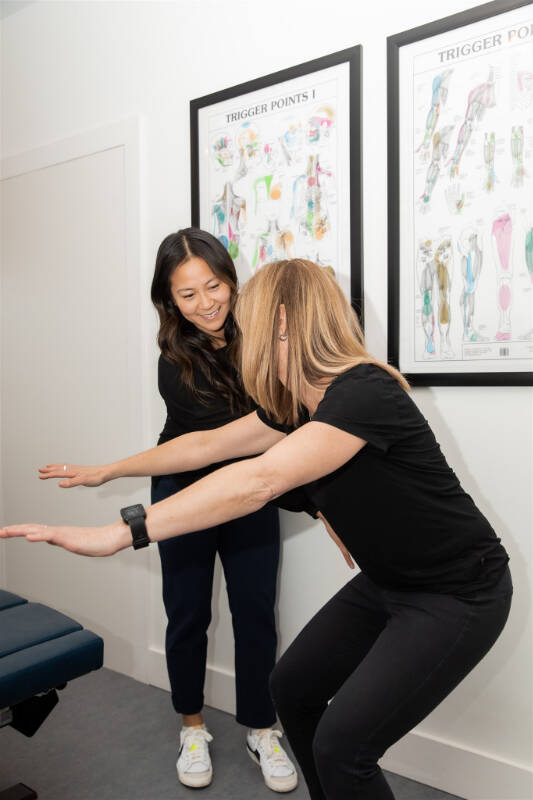If you’ve been dealing with back pain, you’re not alone.
About 80 per cent of people will experience an episode of back pain at some point in their life. Unfortunately, many misconceptions persist about back pain – some reinforced by the media, others by industry groups and well-meaning clinicians. As a result, these beliefs can spiral into unhelpful behaviours.
But while back pain can feel scary, it’s rarely a life-threatening medical condition, and needn’t control your life, says Dr. Caeden Chau, of Fit Chiropractic & Sport Therapy in Courtenay who shares 9 facts about back pain.
1. Aging isn’t a cause of back pain
Age doesn’t predispose you to pain. We often hear that getting older can worsen back pain, but the evidence does not support this.
“Most episodes of pain improve over time, and don’t worsen as we age,” Dr. Chau says. “In fact, the highest prevalence of back pain occurs between our 30s and 50s, and starts to decrease as we get into our golden years.”
2. Persistent back pain is rarely associated with serious tissue damage
Our backs are very strong and resilient, with tissue damage healing a lot faster than we think.
“Within three months, tissues are on the way to being healed,” Dr. Chau says. “A majority of back pain begins with everyday movements, so it may be more related to stress, fatigue, lack of exercise, previous experiences and fears. Our nervous system has a way of turning the volume of pain up or down based on these factors – making the back more sensitive to movement and loading.”
3. Scans rarely show the cause of back pain
Many scary-sounding things are reported on scans that aren’t necessarily associated with the pain being felt, such as disc bulges, degeneration, herniated discs and arthritis. Scans don’t mention that these findings are also commonly found in people without back pain.
“Unfortunately, when people are told these findings are the cause of their pain, they believe their back is damaged, and become fearful and avoidant of activities they love,” Dr. Chau says. “Instead, try thinking about these findings as ‘wrinkles in the back,’ common findings in the majority of spines (with or without pain) rather than debilitating, scary conditions.”
4. Pain with exercise and movement doesn’t mean you’re doing harm
With pain, the spine and surrounding muscles can become very sensitive to touch and movement. Pain during exercise is a reflection of this hypersensitivity, not damage of the tissues.
“Exercise is one of the best things you can do to help treat back pain!” Dr. Chau says. “It’s safe and normal to feel some pain when you start moving – it will often settle as you become more active. Exercise also relaxes the muscles, improves mood, and strengthens the immune system, keeping your body and mind strong and healthy.”

5. Back pain is not caused by poor posture
It may be hard to believe, but there’s no specific posture shown to prevent back pain!
“Everyone’s body is different,” Dr. Chau says. “Some find slouching painful, while others find sitting upright uncomfortable. Current research shows that how we sit, stand and bend doesn’t cause back pain, even if these movements are painful. Varying postures throughout the day is healthy for the back, and highly recommended. It’s safe to perform everyday tasks with a round back and a straight back!”
6. Back pain is not caused by a ‘weak core’
Weak ‘core’ muscles are not associated with back pain.
“In fact, people often tense their ‘core’ to protect themselves from pain,” Dr. Chau says. “It sounds counterintuitive, but this can actually worsen back pain. Imagine moving with a clenched fist after spraining your wrist – how painful would that be!? It’s important to control ‘core’ muscles and use them when needed. Bracing and guarding when in pain isn’t always helpful. Learn to relax your back and ‘core’ during daily tasks.”
7. Backs don’t wear out with everyday loading and bending
Our backs are built to bend, twist and lift.
“Loading the back makes it stronger and more resilient,” Dr. Chau says. “Someone can strain their back lifting something heavy, but that doesn’t mean this movement should be avoided. Gradual and regular loading of the back can help build tolerance, and is completely safe. Many people begin to start running after spraining an ankle – loading the joints again, even after injury, makes them stronger and healthier.”
8. Pain flare-ups don’t mean you’re doing damage
Pain flare-ups are scary and frustrating. Often they come on with everyday movements, and not from injury.
“Similar to headaches, back pain triggers include stress, tension, poor sleep, dehydration and lack of exercise. Improving these factors can help prevent or lessen the intensity of flare-ups.”
9. Extreme measures aren’t usually a cure
Spine injections, surgery and opioids usually aren’t very effective for back pain in the long run, and negative side-effects often outweigh any pain-relief.
“A more conservative approach can be more effective, cheaper and safer than extreme measures,” Dr. Chau says. “Patient-centred education, physical activity, manual therapy and improving mental health is more beneficial in the long term.”
Reframing beliefs about back pain and creating a positive mindset can help decrease pain, build confidence and lessen fear.
Follow Fit Chiropractic & Sport Therapy on Facebook and Instagram, or contact the team at info@fithealth.ca.

